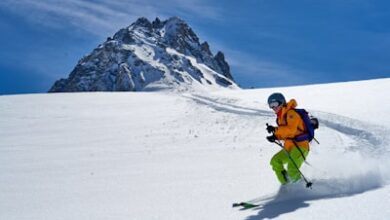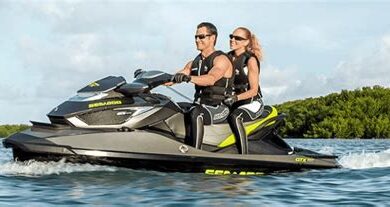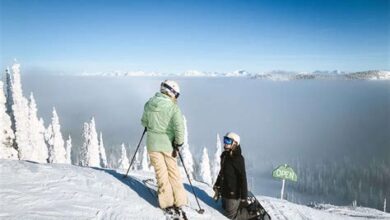What Do You Put On Your Face When Skiing?⏬

Ski season calls for fresh powder, thrilling descents, and the unforgettable rush of wind against your face as you carve down the slopes. Yet, this frosty face-off with nature demands more than just skill; it requires thoughtful preparation to shield your skin from the biting cold and glaring sun. Whether you’re a woman looking to maintain a comfortable and protective barrier, a parent concerned about your child’s delicate skin, a man seeking optimal face coverage, or anyone braving the ski slopes’ chill, knowing the right armor for your face is crucial. In this post, we’ll delve into the necessary gear and products that cater to everyone—from women and kids to men—to ensure your skiing adventure is not only exhilarating but also kind to your skin. So, strap on your boots, adjust your goggles, and let’s explore the essential face protection that will keep you looking as good as your last downhill run!Essential facewear tips for skiing: Find the perfect protection for women, kids, and men against the cold while hitting the slopes.
What Do You Wear On Your Face To Ski For Women
When the snow starts to fall, and the slopes beckon, female skiers are faced with the question: What Do You Wear On Your Face To Ski? Shielding your face from the alpine elements is about balancing comfort with protection. Women often choose gear that protects against the cold, sunburn, and wind, while also considering the incorporation of style into their slope-side look.
For women, the ideal face-wear includes several layers. A high-quality, UV-protective lip balm is essential to prevent chapped lips, which can be both uncomfortable and unsightly. Items such as thermal face masks or balaclavas, while practical for keeping your face warm, can also be found with feminine designs. A lightweight neck gaiter can offer additional warmth and can be pulled up over the lower face when required.
Goggles are non-negotiable for protection against the glare of the sun and maintaining clear vision while descending the slopes. Women’s goggles also come in various sizes and styles to fit both personal taste and helmet compatibility. What To Put On Face When Skiing in cold conditions, beyond a physical barrier, also includes ample sunscreen on any exposed skin to prevent sun damage, even on overcast days.
Additional accessories that cater specifically to women include earbands and headbands that not only keep you warm but can also accommodate hairstyles better than a beanie or hat might. As for What To Cover Your Face With When Skiing for women, using tinted moisturizers or foundations with SPF can act as a protective layer against the cold while providing a touch of glam on the slopes.
To further elaborate, here is how you can organize what to wear on your face when skiing:
- The base layer: A moisturizer or a primer with SPF.
- Physical protection: Choose a balaclava or neck gaiter designed for ski conditions.
- Sun protection: A strong, water-resistant SPF cream or lotion applied to all exposed areas of skin.
- Visual protection: UV-rated ski goggles appropriate for weather conditions.
- Additional warmth and style: Earbands or headbands that fit comfortably under a helmet.
The key to staying comfortable and protected on the slopes is to layer appropriately and select pieces that serve their functional purposes while also representing your personal style. When considering What To Wear On Face For Skiing For Kids or What To Cover Your Face With When Skiing For Men, the principles remain the same though the styles may differ. For women, it’s about finding that sweet spot between fashion, function, and facial protection.
| Item | Description | Purpose |
|---|---|---|
| Lip Balm with SPF | Hydrating and UV protective | Prevents chapped lips |
| Thermal Face Masks | Insulated and may include feminine designs | Shield face from cold and wind |
| Neck Gaiter | Flexible for cover neck and lower face | Adds additional warmth |
| Ski Goggles | UV-rated, various sizes/styles | Protects eyes from glare and snow |
| Earbands/Headbands | Warm, accommodates hairstyles | Keeps ears warm, fits under helmet |
What To Wear On Face For Skiing For Kids
What To Wear On Face For Skiing For Kids is a question that often pops up as parents prepare their little ones for the slopes. Ensuring that your child’s face is protected against the harsh elements and the cold is essential for a safe and enjoyable experience. Skiing exposes kids to strong UV rays, chilly winds, and potential falls, making it crucial to select the right gear for their delicate faces.
When it comes to choosing the appropriate face gear for kids, there are several factors to consider, such as insulation, protection, and comfort. A balaclava or ski mask is particularly important as it covers most of the face while leaving space for goggles, which provide crucial eye protection against the glare of the sun off the snow. Additionally, for kids with sensitive skin, a high SPF sunscreen should be applied diligently to exposed areas of their faces to prevent sunburn.
Beyond sun and wind protection, the chosen face wear should also be breathable and moisture-wicking to keep the kids comfortable during their activities. Below, we’ve compiled a detailed list of suitable face wear for kids while skiing, considering their specific needs for safety and protection:
- Balaclavas or ski masks: These offer full coverage and can come in playful designs that make kids excited to wear them.
- High-quality ski goggles: They should fit well with the helmet and provide not only wind and sun protection but also safety in case of falls.
- Lip balm with SPF: To protect against chapped and sunburned lips which are common in cold, sunny environments.
- Non-irritating sunscreen: Formulated for children’s sensitive skin and offering broad-spectrum protection.
- Neck gaiters or buffs: These can be pulled up over the nose and mouth for added warmth and protection when needed.
Here’s a simple table to summarize the essential face gear for children on the ski slopes:
| Item | Description | Benefits |
|---|---|---|
| Balaclava/Ski Mask | Covers head and neck, leaving space for eyes | Warmth, protection from elements |
| Ski Goggles | Protects eyes from UV rays and enhances visibility | Safety, comfort, UV protection |
| Lip Balm with SPF | Protective barrier for lips | Prevents chapping and sunburn |
| Sunscreen for Children | Non-irritating formula providing broad-spectrum protection | Prevents sunburn, suitable for sensitive skin |
| Neck Gaiter/Buff | Flexible face and neck covering | Versatile, can be used for added heat or protection |
Remember, no matter which type of face gear you select for your child, comfort and fit are paramount to ensure they are both protected and happy on their skiing adventures. Having settled on the perfect What To Wear On Face For Skiing For Kids, rest assured that your child is better equipped to tackle the slopes with confidence and joy.
What To Put On Face When Skiing Cold
When the temperature drops and the slopes call your name, it’s essential to protect your skin against the harsh elements you’ll encounter. The question of What To Put On Face When Skiing Cold isn’t just about comfort; it’s about safety as well. The biting cold, coupled with wind and UV exposure, can be brutal on your face. Ensuring that you have the right protective gear can make all the difference between a great day on the slopes and an uncomfortable experience.
For those looking to shield their skin from frosty conditions, several options are available, ranging from high-tech fabrics to nature’s best ingredients. This blog post dives into the various protective wearables and skincare items you should consider before braving the cold-clad mountain peaks. What Do You Put On Your Face When Skiing? Well, let us explore some options best suited for icy adventures.
Firstly, keeping your skin moisturized is paramount. The dry, cold air can sap the moisture from your face, leading to chapping and irritation. Look for a thick, emollient cream designed for extreme weather conditions. Applying such a protective layer will act as a barrier to the cold while keeping your skin nourished. Additionally, sunscreen is non-negotiable. Despite the chill, the sun’s rays reflect off the snow with increased intensity, making SPF an essential item in your ski pack.
Furthermore, physical barriers such as ski masks, balaclavas, or neck gaiters made from thermal and moisture-wicking materials can serve as the first line of defense. These items help in maintaining warmth and protecting the delicate skin of your face. What To Cover Your Face With When Skiing For Men, What Do You Wear On Your Face To Ski For Women, and What To Wear On Face For Skiing For Kids might vary slightly in style and design, yet the core function remains the same – to offer protection against the cold.
The need for layering and using high-quality skincare and protective gear is clear, and considering your unique needs or preferences can guide your choices. Below is a table summarizing different face protection suggestions for men, women, and children while skiing in cold conditions:
- Ski Mask with Fun Designs
| Category | Item | Description |
|---|---|---|
| General Skincare | Moisturizer with SPF | A thick, hydrating cream to shield against the cold and sun’s rays. |
| Men | Balaclava/Neck Gaiter | Snug-fitting protection that covers the neck and lower half of the face. |
| Women | Thermal Mask | Stylish yet functional gear providing warmth and wind resistance. |
| Kids | Playful patterns to encourage protection amongst the younger skiers. |
Ultimately, when deciding on What To Put On Face When Skiing Cold, you must consider the severity of the weather, your skin type, and the level of activity you’ll be engaging in. Each factor plays a role in how well you’ll be able to keep your face protected and, by extension, how much you’ll be able to enjoy your time on the slopes.
What To Cover Your Face With When Skiing For Men
When planning for the brisk winter environment on the slopes, there’s a critical question that’s often asked by skiers, particularly men seeking functional gear: What to cover your face with when skiing? Ensuring proper protection for your face is vital to not only guard against the cold but also to shield from the sun’s harmful UV rays and harsh winds that one encounters while skiing.
For men, there is a range of options available, and here, we explore several of them. Starting out, one of the most efficient and simple solutions is a balaclava. Designed to offer full-face coverage while retaining breathability, balaclavas are preferred for their snug fit, which can easily be worn under a helmet. Another popular choice for facial protection is a ski mask or face mask, which usually covers the lower half of the face and can be made from materials such as fleece or neoprene for added insulation and moisture resistance.
Some skiers might question, What do you put on your face when skiing in terms of skincare? Moisturizer and sunscreen are crucial to prevent windburn and sunburn, respectively. An SPF of at least 30 is recommended, and it should be reapplied regularly. In addition to skincare, technical fabrics such as Gore-Tex or a wind-resistant fleece can be pivotal in providing the requisite shield against the elements; these materials are often used in the making of ski buffs and neck gaiters, which offer versatile protection for the face and neck and can be easily adjusted based on current conditions.
Frequent skiers are invariably in search of durability and comfort, which is why specially designed ski facewear is essential. When considering what to wear on face for skiing, it’s imperative that men select products tailored for the harsh conditions expected on the slopes. Here’s a basic table outlining a few common options along with their defining characteristics:
| Face Covering | Material | Characteristics |
|---|---|---|
| Balaclava | Polyester, Merino Wool, or Synthetic Blends | Full-face coverage, fits under helmets, breathable |
| Ski Mask/Face Mask | Fleece, Neoprene | Insulating, water-resistant, covers lower face |
| Buff/Neck Gaiter | Technical Fabrics (e.g., Gore-Tex) | Wind-resistant, adaptable for face and neck, moisture-wicking |
Ultimately, the decision of what to cover your face with when skiing for men should be based on individual preference, weather conditions, and functionality. The aforementioned options, among others, serve as a guide to help male skiers make informed decisions for their comfort and protection while enjoying their time on the slopes.
Frequently Asked Questions
Why is it important to protect your face while skiing?
Protecting your face while skiing is important due to the cold and often harsh conditions on the slopes. Exposure to low temperatures, wind, and the sun’s UV rays at high altitudes can cause frostbite, windburn, and sunburn. Adequate protection helps to prevent these skin issues and enhances comfort and safety while skiing.
What types of products are recommended for facial skin care when skiing?
For skiing, it is recommended to use a high-SPF, broad-spectrum sunscreen to protect against UV rays, a moisturizer to keep skin hydrated, and a lip balm to prevent chapped lips. Products should be water-resistant and suitable for cold climates.
Are there any specific ingredients to look for in sunscreen for skiing?
When choosing sunscreen for skiing, look for ingredients like zinc oxide or titanium dioxide for broad-spectrum protection. Also, ensure it has an SPF of 30 or higher to provide effective protection against the intensified UV rays at higher elevations.
Is it necessary to reapply sunscreen throughout the day while skiing?
Yes, it is necessary to reapply sunscreen every two hours, or more frequently if you are sweating heavily or wiping your face often. Sun exposure can be intense on the slopes due to reflection off the snow, so regular application ensures ongoing protection.
What type of face mask is best for cold and windy conditions while skiing?
A balaclava or a ski mask made from a moisture-wicking and insulating material such as merino wool or a synthetic blend is best for cold and windy conditions. It should fit comfortably, cover the entire face and neck, and provide ventilation around the mouth to prevent moisture buildup.
Can wearing goggles protect your face when skiing?
Wearing goggles can protect the sensitive skin around your eyes from UV rays, wind, and icy particles. They provide a shield against the elements and help to prevent eye injuries. Make sure the goggles offer UV protection and fit well with your helmet.
How should someone with sensitive skin protect their face when skiing?
Someone with sensitive skin should use fragrance-free and hypoallergenic products to reduce the risk of irritation. It’s also beneficial to choose a sunscreen for sensitive skin, apply a thicker moisturizer, and wear a soft, breathable face covering to protect against the harsh skiing environment.









